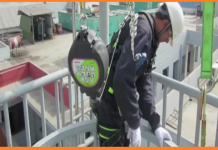Work at height is an integral part of construction activities, but it comes with inherent risks that demand stringent safety measures. Accidents can happen, and being prepared for emergencies is very important to safeguard the lives of workers. This article explores the importance of emergency rescue for work at height in construction sites, Types of rescue equipment’s and outlines key strategies to ensure the prompt and effective response to potential incidents.
Risk Assessment and Prevention:
Before delving into emergency rescue procedures, it is essential to conduct a thorough risk assessment. Identifying potential hazards, such as unstable structures, adverse weather conditions, Failure of scaffolding or inadequate personal protective equipment, allows for the implementation of preventive measures. These may include proper training, the use of safety harnesses, guardrails, and other fall protection systems.

Emergency Rescue Planning:
Developing a detailed emergency rescue plan is a cornerstone of ensuring the safety of workers at height. This plan should be prepared to the specific site, considering factors such as the height of the work, the nature of the tasks being performed, and the availability of resources.
Key Components of an Emergency Rescue Plan:
- Training:
- All personnel involved in work at height should receive thorough training in emergency rescue procedures.
- This includes familiarizing workers with the use of rescue equipment, communication protocols, and evacuation routes.
- Communication Systems:
- Establish clear communication channels to relay emergency information promptly.
- Provide workers with radios or other communication devices to maintain contact with the ground and emergency response teams.
- Rescue Equipment:
- Ensure the availability and proper maintenance of rescue equipment, including harnesses, lanyards, descent devices, and first aid supplies.
- Conduct regular inspections and training drills to guarantee the effectiveness of the equipment in real-life scenarios.
- Emergency Response Teams:
- Designate and train a specialized team responsible for responding to work-at-height emergencies.
- Ensure that team members are well-versed in rescue techniques, equipment usage, and first aid procedures.
- Evacuation Procedures:
- Establish clear evacuation procedures for workers at height in case of an emergency.
- Practice regular drills to familiarize workers with evacuation routes and procedures.
- Coordination with Emergency Services:
- Establish protocols for coordinating with external emergency services, such as fire departments and medical personnel.
- Provide them with site-specific information to expedite their response in case of an incident.
- Post-Incident Evaluation:
- After any emergency rescue operation, conduct a thorough review to identify areas for improvement.
- Use the lessons learned to update and enhance the emergency rescue plan.
Emergency rescue from work at height in construction sites is a critical aspect of ensuring the safety of workers. By implementing risk assessments, thorough training, and well-defined emergency rescue plans, construction sites can minimize the impact of potential incidents and enhance the overall safety culture. Proactive measures not only save lives but also contribute to the efficiency and success of construction projects. Remember, in the realm of work at height, preparedness is paramount.

Types of rescue equipment for work at height
Ensuring the safety of workers at height in construction or industrial site requires the use of specialized rescue equipment. The choice of equipment depends on the nature of the work, the height involved, and the specific risks associated with the tasks. Here are some rescue equipment’s commonly used for work at height:
- Fall Arrest Systems:
- Harnesses: Full-body harnesses distribute the force of a fall throughout the body, preventing injuries. They are a fundamental component of a fall arrest system.
- Lanyards: These are flexible lines that connect the harness to an anchor point, allowing limited movement while preventing a fall.
- Shock Absorbers: Integrated into lanyards, these devices absorb and dissipate the energy generated during a fall, reducing the impact on the body.
- Fall Restraint Systems:
- Positioning Lanyards: These limit a worker’s movement to prevent them from reaching a fall hazard. They are used in conjunction with a full-body harness.
- Rescue Descenders:
- Descender Devices: These allow controlled descent during a rescue operation. They are crucial for safely lowering a worker to the ground after a fall.
- Evacuation and Descent Systems:
- Evacuation Devices: Battery-powered or manually operated devices designed for quick and controlled descent during emergency evacuation from height.
- Rescue and Evacuation Kits: Comprehensive kits may include harnesses, descenders, pulleys, and other components necessary for a successful rescue or evacuation.
- Tripods and Davits:
- Confined Space Rescue Systems: Used for confined space work at height, these systems often include tripods and davits to provide a stable anchor for rescue operations.
- Rescue Ropes and Rigging:
- Static Kernmantle Ropes: High-strength, low-stretch ropes designed for rescue operations. They are often used with descenders and other rigging devices.
- Pulleys: Used to create mechanical advantage, allowing rescuers to lift or lower a load more easily.
- Communication Equipment:
- Two-Way Radios: Essential for maintaining communication between workers at height and those on the ground or in control rooms.
- Headsets: Hands-free communication systems can improve coordination during rescue operations.
- Personal Protective Equipment (PPE):
- Helmets: Protect the head from falling objects and other hazards.
- Gloves: Provide hand protection during rope work and rescue operations.
- Eye Protection: Goggles or safety glasses to shield the eyes from debris and other potential hazards.
- First Aid Kits:
- Trauma Kits: Include basic first aid supplies and equipment to address injuries sustained during a fall or rescue operation.
It’s important to note that rescue equipment should be inspected regularly, and workers should be adequately trained in its use. Additionally, all equipment should comply with relevant safety standards and regulations to ensure effectiveness in emergency situations.
Click here FOR 👉 Download PDF copy of RESCUE PLAN FOR WORK AT HEIGHT
Click here FOR 👉 Download WORD copy of RESCUE PLAN FOR WORK AT HEIGHT





